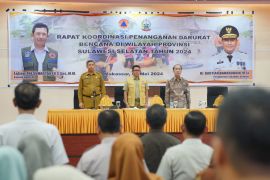In Semarang, the floodwaters reaching a height of between 30 centimeters and one meter, submerged several areas, including Old City and Johar traditional market.
Setiawan (38), a Tanah Mas resident, said in Semarang, Wednesday that he could not go to his office because all roads towards his office area were flooded.
Other Semarang`s flood-affected areas included Tanah Mas residential area, Hasanudin street, Imam Bonjol street, Bubakan, Citarum street, Kaligawe street, Tlogosari housing complex, and Mangkang. The floods caused traffic jams on some roads.
Meanwhile in Pontianak, two schools at Pimpinan village, Teluk Keramat sub district, Sambas District, were temporarily closed because their class rooms were flooded.
"We are forced to cease the class activities because the class rooms have been submerged under floodwaters at a height of 50 cm since Tuesday evening (Jan 11)," Ridwan, a staffer of one of the flooded schools, said in Pontianak, Wednesday.
Almost every year, the school is inundated, according to Ridwan.
Tens of houses were also flooded at Pimpinan village, Pimpinan Village Head Andes said.
Indonesia has been affected by La Nina phenomena since last year, causing the nation to experience extended rainy season.
According to the Maryland-based National Oceanic and Atmospheric Administration (NOAA)`s National Weather Service, La Nina might continue until March 2011.
"Enhanced low-level easterly trade winds and anomalous upper-level westerly winds continued over the equatorial Pacific. Collectively, these oceanic and atmospheric anomalies reflect a moderate-to-strong La Nina," said NOAA`s National Weather Service in its press statement received by ANTARA recently.
Likely La Nina impacts during December 2010-February 2011 would include enhanced convection over Indonesia, the US weather service added.
The Indonesian authorities have warned the public to anticipate an increase in hydrometeorological disasters in the country, especially in the January-March period.(*)
Editor: Jafar M Sidik
Copyright © ANTARA 2011











